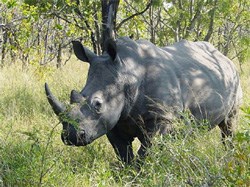
Top stories


Marketing & MediaCammy Msimango on finding her footing in South Africa’s fast-moving digital newsroom
Esther Tomorrow, MDNTV 23 hours




More news




About 24 rhinos have been killed in South Africa since the beginning of this month, while figures from the South African National Parks (SANPARKS) show that 448 rhinos were killed for their horns last year alone. The most affected areas were said to be in Limpopo and North West provinces.
Experts say the spike in poaching in Africa and South Asia was largely caused by increased demand for rhino horns in Asian traditional medicine. There are still many myths associated with the rhino horn in some Asian countries like China and Vietnam, where it is believed that the horn can heal fever, enhance sexual performance and reduce chances of stroke.
Molewa said it was clear that authorities needed to up their game in curbing the poaching of rhinos.
"It is clear that this is an organised crime and in dealing with organised criminals, we need input and action from all South Africans."
She said a study conducted had indicated that the decision on whether or not to dehorn a rhino population depended on a number of factors, including the level of poaching threat, the availability of funds and the size of the rhino population in question.
"Due to the invasive nature of and expenses associated with dehorning, the intervention should only be considered under conditions of relatively severe poaching threat," Molewa said.
A continuing study commissioned by government will also look into whether legalising trade in rhino horn could help to bring down poaching.
Other measures include the establishment of the National Wild Life Reaction Unit, which authorities are hoping will help in information sharing and curbing poaching in South Africa's largest parks.

Molewa said the South African National Defence Force has also been returned to monitor the 350km of the national border in Kruger National Park. Most of the country's rhinos are found in Kruger Park, leading to many cases of poaching being reported there.
While the alarming figures of rhino killing in the country had raised concerns among animal rights groups and activists, SANPARKS said it was not yet time to press panic buttons.
According to the organisation's CEO David Mabuza, there are around 22 000 rhinos in South Africa, accounting for 93% of the world's rhino population. The rhino population is said to be growing at a rate of 6% a year.
"So while all of us should be worried, it should be noted that the killings have not yet threatened the rhino population in general. But if we continue at this rate (of killing), we will start seeing a decline by 2015," Mabuza said.
SANPARKS needs about 1600 additional rangers to patrol in the Kruger National Park but this would mean an additional R200 million in the budget.
SAnews.gov.za is a South African government news service, published by the Government Communication and Information System (GCIS). SAnews.gov.za (formerly BuaNews) was established to provide quick and easy access to articles and feature stories aimed at keeping the public informed about the implementation of government mandates.
Go to: http://www.sanews.gov.za